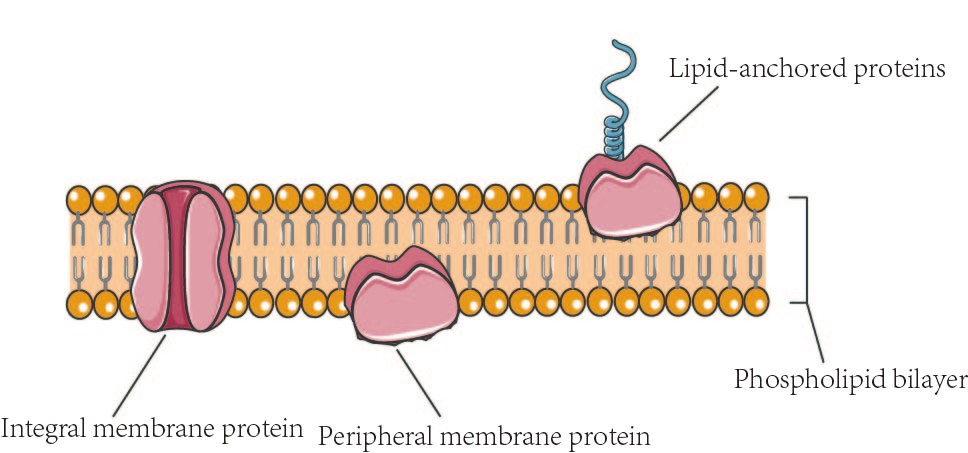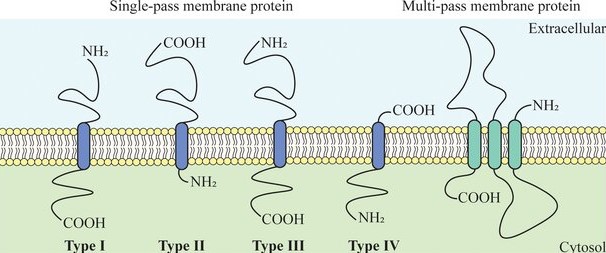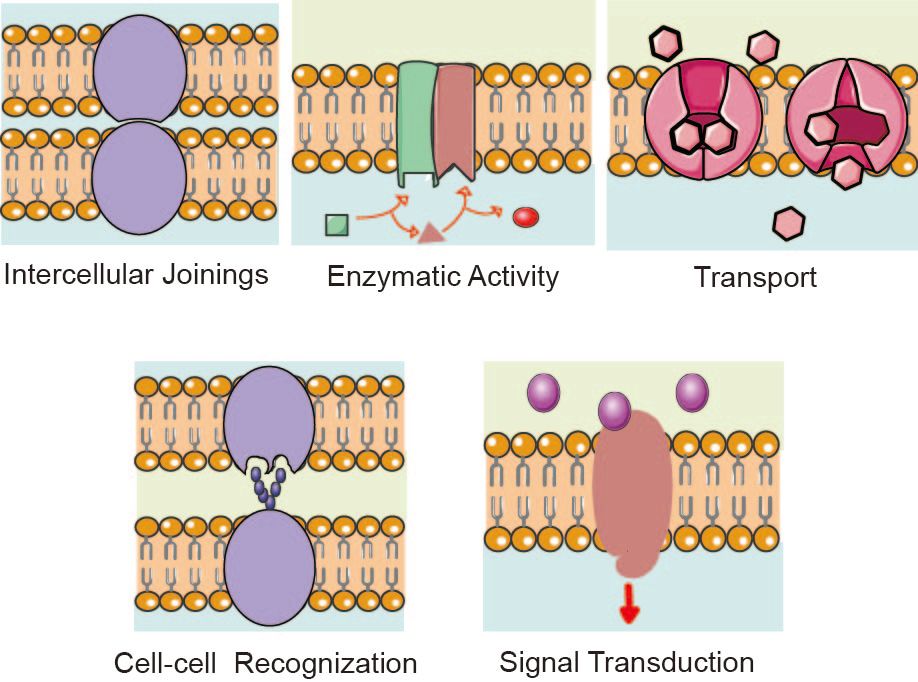Types and Functions of Membrane Proteins
Membrane proteins are vital components associated with or anchored to the membranes of cells or organelles. They play a crucial role in maintaining cell integrity, enabling cell communication, and facilitating transport processes across the cell membrane, which separates the internal environment of the cell from the outside world.
What are Membrane Proteins?
Membrane proteins either integrate into the lipid bilayer or associate with its surface. The cell membrane, or plasma membrane, is a lipid bilayer that encloses the cell, acting as a barrier and offering protection. These proteins exhibit both hydrophilic (water-attracting) and hydrophobic (water-repelling) properties, which enable their stable integration and function within the phospholipid bilayer.
Hydrophilic Regions: These polar parts of membrane proteins are usually found on the protein's surface, where they can interact with water molecules or the polar head groups of membrane lipids.
Hydrophobic Regions: Comprising non-polar amino acid residues, these regions often form transmembrane α-helices or β-barrel structures that integrate into the hydrophobic core of the phospholipid bilayer, avoiding interaction with water.
Types of Membrane Proteins
Membrane proteins can be broadly categorized into three groups based on their location and interaction with the lipid bilayer:
- Integral Membrane Proteins (Intrinsic Proteins)
- Peripheral Membrane Proteins (Extrinsic Proteins)
- Lipid-Anchored Proteins
 Figure 1. Three types of membrane proteins.
Figure 1. Three types of membrane proteins.
Integral Membrane Proteins
Integral membrane proteins, or intrinsic proteins, embed themselves within the phospholipid bilayer and are stabilized by interactions between their hydrophobic amino acid residues and the hydrophobic phospholipid tails. These proteins are essential for various cellular functions, including transport, signaling, and structural integrity.
A key subset of these proteins is transmembrane proteins, which extend across the lipid bilayer and have sections exposed on both the interior and exterior surfaces of the cell membrane. They typically comprise one or more alpha-helices or beta-barrels, which interact with the membrane's hydrophobic core, while their hydrophilic regions protrude into the aqueous environments inside and outside the cell.
 Figure 2. Several types of transmembrane proteins. (Pauwels J, et al., 2022)
Figure 2. Several types of transmembrane proteins. (Pauwels J, et al., 2022)
Structure of Transmembrane Proteins
Transmembrane proteins typically have one or more alpha-helices or beta-barrels that span the membrane. Alpha-helical proteins are more common and can function as channels or receptors. The hydrophobic regions of these proteins interact with the membrane's hydrophobic core, while hydrophilic regions protrude into the aqueous environments inside and outside the cell.
These proteins span the phospholipid bilayer with one (single-pass) or several (multipass) segments. Single-pass membrane proteins can be further categorized into various types, as classified in UniProt.
Type I: N-terminus on the extracellular side with the signal peptide removed.
Type II: N-terminus on the cytosolic side, with the transmembrane (TM) domain near this terminus acting as an anchor.
Type III: N-terminus on the extracellular side but lacking a signal sequence.
Type IV: N-terminus on the cytosolic side, with the TM domain near the C-terminus serving as an anchor.
Functions of Transmembrane Proteins
- Transporters and Channels: These proteins facilitate the movement of ions, nutrients, and other molecules across the cellular membrane. For example, aquaporins allow water molecules to pass through the membrane.
- Receptors: Transmembrane proteins like G-protein coupled receptors (GPCRs) play a critical role in cellular signaling, receiving external signals and initiating a response within the cell.
- Cell Adhesion: Some transmembrane proteins are involved in cell adhesion, helping cells attach to each other or to the extracellular matrix. Examples include cadherins and integrins.
Peripheral Membrane Proteins
Peripheral membrane proteins, also known as extrinsic membrane proteins, are proteins attached to the inner and outer surfaces of the cell membrane, making up 20-30% of all membrane proteins. Unlike integral membrane proteins, which are amphipathic and embedded within the lipid bilayer (with some spanning the entire bilayer and exposed on both sides, known as transmembrane proteins), peripheral membrane proteins do not penetrate the lipid bilayer. Instead, they bind to the polar head groups of lipid molecules or to the hydrophilic regions of transmembrane proteins through ionic bonds. These proteins are entirely exposed on either side of the lipid bilayer and are only indirectly associated with the membrane.
 Figure 3. Schematic representation of peripheral proteins. (Pauwels J, et al., 2022)
Figure 3. Schematic representation of peripheral proteins. (Pauwels J, et al., 2022)
Characteristics of Peripheral Membrane Proteins
Peripheral proteins attach to the membrane via several mechanisms: electrostatic interactions with negatively charged phospholipids and positively charged residues or cofactors (such as Ca²⁺ ions), insertion of a hydrophobic loop, covalent bonding with a lipid anchor (like phosphatidylinositol), or through an amphipathic in-plane α-helix.
These water-soluble proteins are weakly bound to the membrane and can be easily separated by altering the ionic strength or pH of the solution, without disrupting the membrane's basic structure.
Functional Roles of Peripheral Membrane Proteins
Peripheral membrane proteins serve various functions within the cell:
- Cytoskeleton Attachment: Many peripheral proteins connect the cell membrane to the cytoskeleton, helping to maintain cell shape and facilitate cell movement.
- Enzymatic Activity: These proteins can also serve as enzymes, catalyzing reactions that take place on the membrane's surface.
- Signal Transduction: They can act as enzymes or adaptor molecules in signal transduction pathways. They often respond to signals received by membrane-bound receptors.
For example, proteins like spectrin and ankyrin in red blood cells are peripheral proteins that are crucial for maintaining cell structure and function. Cytochrome c, another peripheral protein, binds to the outer surface of the mitochondrial inner membrane through electrostatic interactions.
Lipid-Anchored Proteins
Lipid-anchored proteins are covalently attached to lipid molecules embedded in the cell membrane.
Key Features of Lipid-Anchored Proteins
These proteins are linked to the membrane via lipid groups like GPI anchors (glycosylphosphatidylinositol) or prenyl groups. The lipid anchors allow the protein to attach firmly to the membrane.
Functions of Lipid-Anchored Proteins
- Cell Signaling: Many lipid-anchored proteins are involved in signal transduction, where they can act as receptors or enzymes.
- Membrane Trafficking: These proteins help in vesicle formation, trafficking, and fusion, processes vital for the transport of molecules within cells.
Cellular Functions of Membrane Proteins
The diverse types of membrane proteins work collectively to support various critical functions of the cell membrane. Their roles can be grouped into several key categories:
 Figure 4. Schematic representation of membrane protein cellular functions.
Figure 4. Schematic representation of membrane protein cellular functions.
1. Structural Support
Membrane proteins contribute to the structural integrity of cells by connecting the cytoskeleton to the cell membrane. This connection helps in maintaining cell shape, enabling movement, and facilitating division.
2. Enzymatic Activity
Some membrane proteins have enzymatic roles, catalyzing specific biochemical reactions at the membrane surface. For example, enzymes involved in ATP synthesis during cellular respiration are located on the inner mitochondrial membrane.
3. Transport and Permeability
Membrane proteins regulate the movement of substances across the cell membrane. Channels and pumps facilitate the selective passage of ions, small molecules, and macromolecules. For instance, the sodium-potassium pump, an integral protein, maintains the cellular ion gradient critical for cell function.
4. Cell Recognition and Communication
Certain membrane proteins serve as markers that allow cells to recognize each other, facilitating communication and interaction. Glycoproteins, which are proteins with carbohydrate groups, are essential for cell-cell recognition and immune responses.
5. Signal Transduction
Membrane proteins play a fundamental role in signal transduction pathways. When a signal molecule binds to a membrane receptor, a cascade of intracellular events is triggered, leading to a cellular response. GPCRs and receptor tyrosine kinases are examples of receptors involved in these pathways.
At Creative Biostructure, we specialize in the field of membrane proteins and offer an advanced cell-free expression system where membrane proteins are expressed within lipid vesicles.
| Cat No. | Product Name | Source |
| BAK1-1050L | BAK1 Liposome | Cell-free expression system |
| BDKRB2-1049L | BDKRB2 Liposome | Cell-free expression system |
| BR-1051L | BR Liposome | Cell-free expression system |
| CCR1 -1052L | CCR1 Liposome | Cell-free expression system |
| CCR2-1053L | CCR2 Liposome | Cell-free expression system |
| CCR5-1054L | CCR5 Liposome | Cell-free expression system |
| Explore All Membrane Protein Liposomes | ||
We offer a variety of membrane proteins, membrane-associated protein products, and custom membrane protein production services to support your membrane protein research needs. We can express and purify membrane proteins that are currently unavailable in the market, including GPCRs, ion channels, transporters, enzymes, and viral targets. Our expertise ensures that you receive high-quality, stable membrane proteins, advancing your research and drug development efforts. If you are interested in our services and products, please feel free to contact us for more information.
Reference
- Pauwels J, Fijałkowska D, Eyckerman S, et al. Mass spectrometry and the cellular surfaceom. Mass Spectrometry Reviews. 2022. 41(5): 804-841.
